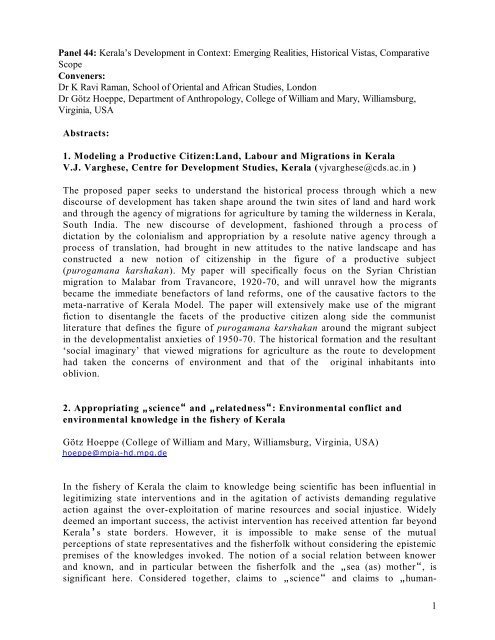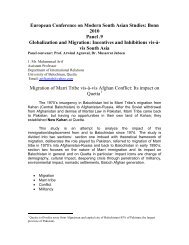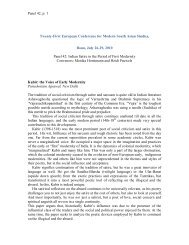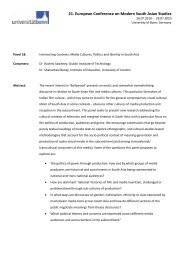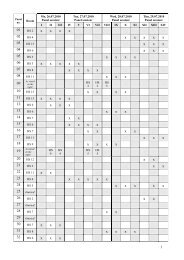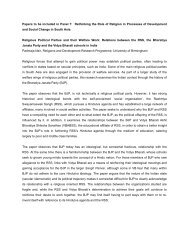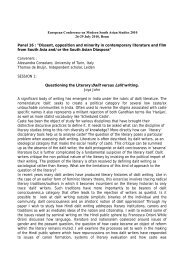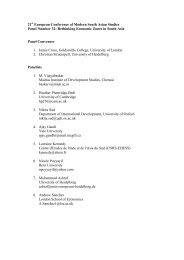Curriculum Vitae - Universität Bonn
Curriculum Vitae - Universität Bonn
Curriculum Vitae - Universität Bonn
You also want an ePaper? Increase the reach of your titles
YUMPU automatically turns print PDFs into web optimized ePapers that Google loves.
Panel 44: Kerala‟s Development in Context: Emerging Realities, Historical Vistas, Comparative<br />
Scope<br />
Conveners:<br />
Dr K Ravi Raman, School of Oriental and African Studies, London<br />
Dr Götz Hoeppe, Department of Anthropology, College of William and Mary, Williamsburg,<br />
Virginia, USA<br />
Abstracts:<br />
1. Modeling a Productive Citizen:Land, Labour and Migrations in Kerala<br />
V.J. Varghese, Centre for Development Studies, Kerala (vjvarghese@cds.ac.in )<br />
The proposed paper seeks to understand the historical process through which a new<br />
discourse of development has taken shape around the twin sites of land and hard work<br />
and through the agency of migrations for agriculture by taming the wilderness in Kerala,<br />
South India. The new discourse of development, fashioned through a pro cess of<br />
dictation by the colonialism and appropriation by a resolute native agency through a<br />
process of translation, had brought in new attitudes to the native landscape and has<br />
constructed a new notion of citizenship in the figure of a productive subject<br />
(purogamana karshakan). My paper will specifically focus on the Syrian Christian<br />
migration to Malabar from Travancore, 1920-70, and will unravel how the migrants<br />
became the immediate benefactors of land reforms, one of the causative factors to the<br />
meta-narrative of Kerala Model. The paper will extensively make use of the migrant<br />
fiction to disentangle the facets of the productive citizen along side the communist<br />
literature that defines the figure of purogamana karshakan around the migrant subject<br />
in the developmentalist anxieties of 1950-70. The historical formation and the resultant<br />
„social imaginary‟ that viewed migrations for agriculture as the route to development<br />
had taken the concerns of environment and that of the original inhabitants into<br />
oblivion.<br />
2. Appropriating „science“ and „relatedness“: Environmental conflict and<br />
environmental knowledge in the fishery of Kerala<br />
Götz Hoeppe (College of William and Mary, Williamsburg, Virginia, USA)<br />
hoeppe@mpia-hd.mpg.de<br />
In the fishery of Kerala the claim to knowledge being scientific has been influential in<br />
legitimizing state interventions and in the agitation of activists demanding regulative<br />
action against the over-exploitation of marine resources and social injustice. Widely<br />
deemed an important success, the activist intervention has received attention far beyond<br />
Kerala’s state borders. However, it is impossible to make sense of the mutual<br />
perceptions of state representatives and the fisherfolk without considering the epistemic<br />
premises of the knowledges invoked. The notion of a social relation between knower<br />
and known, and in particular between the fisherfolk and the „sea (as) mother“, is<br />
significant here. Considered together, claims to „science“ and claims to „human-<br />
1
environment relatedness“ illuminate shifts in how state representatives and members of<br />
the fisherfolk conceived of their relationship under colonial rule and after the transition<br />
to India’s independence in 1947.<br />
I shall consider this development, focusing on two issues. Firstly, a ban on the fishery of<br />
the Indian oil sardine, as it was issued by the British colonial administration in the last<br />
years of its rule (1943-47), based on scientific investigations made locally by the<br />
Madras Fisheries Department. Secondly, the debate on installing a seasonal ban on<br />
trawling and purse-seining (both regarded as ecologically destructive fishing techniques)<br />
which has received much public attention since the early 1980s.<br />
3. Situating Narayana Guru within the incommensurability between his epistemic<br />
and social locations<br />
J. Reghu, Institute of Encyclopedia Publications, Thiruvananthapuram<br />
jreghu@gmail.com<br />
Narayana Guru could be epistemically located within the fold of the conceptual<br />
apparatus of advaita vedanta, which has been the central discursive instrument held by<br />
the „dominant minority‟ of the caste-Hindus. His conscious thinking was subsumed<br />
under his internalization of renunciation (sannyasa) and the entextualization of its<br />
traditional discourse. This paper argues that the epistemic location of Narayana Guru<br />
was incommensurable with his own social location. A person, whose social location is<br />
on the side of the oppressed, is not automatically qualified to speak from a subaltern<br />
epistemic location. But, this incommensurability is capable of producing some „exterior<br />
spaces‟, not fully integrated into his epistemic location. It is proposed here that, this<br />
epistemic exteriority is to be located within the „disjunctures‟ between Narayana Guru‟s<br />
epistemic location and his socio-political interventions. Narayana Guru‟s failure in delinking<br />
himself epistemically from the conceptual foundation of vedanta was because of<br />
his unawareness of his own epistemic exteriority. The relatively free exterior spaces of<br />
one‟s thought world has a potential for epistemic re-location. This paper is an attempt<br />
at epistemic re-location of Narayana Guru and to situate his radical political praxis<br />
within his epistemic exteriority.<br />
4. Defying Irrepresentability, Othering and Social Exclusion:<br />
Re-visiting the Travancore Experience.<br />
Dr. M.M. Khan, Government Women’s College, Thiruvananthapuram, Kerala<br />
myd_khan@yahoo.co.in<br />
The processes of self representation to assert one‟s own identity and to capture their<br />
denied social space are viewed as the dynamic actions defining historical<br />
transformations.<br />
In Travancore, the non-caste Hindus remained ghettoized for many centuries on account<br />
of caste system and so incapacitated to represent by themselves. The social set -up based<br />
on caste and its murderously oppressive institutions held sway over the micro aspects of<br />
2
social life, thought to be unassailable and immutable. This paper attempts to unravel the<br />
complexities involved in the Civic Right Movement (1918-22), which interrogated this<br />
long prevailed context. The movement was a powerful surge of non- caste and non-<br />
Hindus against the state of Travancore. It considered maintenance of caste system as its<br />
primary duty (Dharma) and any deviation is viewed as fall (Dharmabrahamsha).<br />
Anti- Muslim (Islam) and Christian campaign was unleashed to strengthen the Hindu<br />
national sentiments and they were carefully constructed as „Others‟ to imagine the<br />
Nation. But here this „Othering‟ was deconstructed by forging an alliance between noncaste<br />
and non-Hindus. The paper argues in this context that the realm of engagement of<br />
transformation of Travancore into a modern democratic society contest the legacy of<br />
modern Indian nation.<br />
5. The Latin Catholics and their diet: a note on one of Kerala’s peculiarities<br />
Miriam Benteler, Freie Universität Berlin, miriambenteler@web.de<br />
In their article on food among Muslims and Hindus in Kerala, Caroline and Filippo Osella (2008)<br />
point in the very first sentence to the exceptionality of the state and underline as one of its<br />
unique features the high percentage of non-Hindus. Though the Latin Catholics as one of these<br />
non-Hindu groups share basic values with the surrounding Hindus, there are certain concepts<br />
connected with their religious affiliation which certainly set them apart. In continuation of the<br />
mentioned article, these differences are explored in the realm of „food‟. Among the Latin<br />
Catholics, there are next to no restrictions concerning diet, and non-vegetarianism is not only<br />
emphasised in everyday life, but also at ritual occasions. Catholic food habits thus often run<br />
contrary to Hindu concepts of purity, pollution and caste, and thus provide a field in which<br />
Christian notions differ considerably.Rather than dealing with the „Kerala development model‟ as<br />
such, the paper concentrates on one of the state‟s exceptionality, the Christian community, which<br />
seems, given the number of educational and health institutions run by Christians organisations, to<br />
have not insignificantly contributed to its reputation as a „model state‟.<br />
6. Religion, Education and Democracy: The Emergent Transformative Players<br />
K. Ravi Raman,(Research Associate, SOAS, London: ravi.raman@manchester.ac.uk)<br />
The present paper addresses the likely impact of the emergent custodians on higher<br />
education – the dominant religious and caste groups - in terms of the secular and ethical<br />
education, which formed the bedrock of the Kerala model of social development? The<br />
demand for greater autonomy for the emergent governance structures has led to a crisis<br />
situation wherein religious and caste groups have declared their intention to launch a<br />
second 'liberation struggle', the first one having been staged in the immediate postindependence<br />
phase and having succeeded in pulling down the communist government<br />
in 1959.What has been the content of conflicts over the transformation of education in<br />
the state, the history of which dates back to the missionaries and renaissance<br />
movements? How have the dominant religious/caste forces come to represent and<br />
articulate the question of higher education in Kerala? What would be the implications<br />
of such interventions in terms of knowledge production and academic freedom when<br />
commerce is linked with education through institutions run directly by religious/caste<br />
3
groups particularly considering the Supreme Court verdict that it is „unholy‟ to bring<br />
commerce into educational institutions?<br />
7.Unveiling the Janus: Understanding Modernity in Kerala<br />
Nissim Mannathukkaren, Dalhousie University, Canada<br />
(nmannathukkaren@Dal.Ca<br />
In recent times the concept of modernity has increasingly come under scrutiny. The<br />
desirability or even the impossibility of imitating Western models of development has<br />
become obvious to critics. Hence there has emerged the debate on „alternative<br />
modernities‟ and „multiple modernities‟ which has put serious question marks on the<br />
universalist aspirations of European Enlightenment. At the same time, while the<br />
modernity project has been dissected and debunked in the academic sphere it is still<br />
celebrated at the popular level in many parts of the South, especially in the<br />
economically buoyant areas. That is why it is necessary to understand such<br />
contradictions so as to gauge the problems and prospects of human liberation in the<br />
South. Kerala proves to be an excellent case study for understanding the trajectory of<br />
modernity in non-Western countries for it is one of the most celebrated cases of<br />
development in the world with its achievement of remarkable levels of human<br />
development and democratic governance despite low levels of per capita GDP. While<br />
Kerala has achieved significant successes in reducing poverty and material deprivation,<br />
it has generated new problems not all of which are material. In a preliminary theoretical<br />
exploration, this paper will seek to situate the contradictions which allow many<br />
liberatory tendencies to coexist with some of the most conservative ones within the<br />
emerging debates on modernity.<br />
8. Indigenism and class in a Paniya colony: Pathways of belonging after the<br />
Muthanga struggle<br />
Luisa Steur, Central European University, Budapest (luisasteur@yahoo.co.uk)<br />
What Anna Tsing calls “travelling models of indigenous voice” have also from the<br />
1990s onwards found their way into Kerala, where we see the rise of modern political<br />
organizing focused around the notion of “indigenous” culture and history, culminating<br />
in the 2003 land occupation of the Muthanga wildlife sanctuary as an “adivasi<br />
homeland”. This paper focuses on the experiences of a group of Paniya workers, all<br />
from a particular nearby colony, who took part in the Muthanga struggle, to explore the<br />
ways in which people identified with the discourse of indigenism. It argues that rather<br />
than substantive historical differences, it is an expanded, relational notion of class that<br />
explains why in the aftermath of the colony‟s failed attempt to attain land at Muthanga,<br />
some of its inhabitants started to interpret their history and position vis-à-vis others<br />
through the lens of indigenism, whereas others explicitly rejected the idea of “adivasi”<br />
culture. In exploring these pathways of belonging, I also hope to shed so me light on the<br />
way global discourses of indigenism become locally mediated in Kerala today.<br />
4
9. Revisiting the 'Turnaround' Debate:<br />
An Appraisal of the Contemporary Growth Dynamics of the Kerala Economy<br />
Subin Dennis, Ph.D. Scholar, Centre for Economic Studies and Planning, School of<br />
Social Sciences, Jawaharlal Nehru University, New Delhi.<br />
subindennis@gmail.com<br />
An important criticism against the “Kerala model” of development was the sluggish pace of<br />
expansion in economic production in the state, reflected in the growth impasse of the 1970s and<br />
the 1980s. Many scholars evinced the apprehension that this would impinge upon the finances of<br />
the state, thus jeopardizing the sustainability of the heavily welfare-oriented Kerala model and<br />
threatening the very foundations of the achievements on the human development front.<br />
The recent realisation that the economic growth of the state had picked up since the late 1980s<br />
has led to the emergence of a new literature which focusses on the “turnaround” in the growth<br />
performance of the economy. The most widely held view in this literature has been that the<br />
revival in growth was due to increased remittance inflows that induced a rise in consumption<br />
demand, which drove up growth rates.<br />
My paper argues that the “remittance-led growth” argument is inadequate as an explanation for<br />
the growth turnaround. Using evidence from surveys and micro-level studies as well as wellknown<br />
insights from economic theory, the paper shows that the impact of the consumption<br />
expenditure of emigrants‟ households on the commodity-producing sectors of the state economy<br />
was lower than that of households without emigrants. A sizable part of the consumption of<br />
emigrants‟ households was of a conspicuous nature and highly import-intensive. Moreover, at<br />
the margin, the likelihood of increments in income being parked in banks or spent on land<br />
purchases, etc. is higher in the case of emigrants‟ households. Thus the multiplier effects on<br />
domestic output of the increased consumption expenditure due to increased remittance inflows<br />
was lower than was suggested by the remittanceled growth argument, with the implication that<br />
the stimulus for the growth turnaround might have come from elsewhere. Putting forward an<br />
alternative explanation for the revival in growth, the paper demonstrates that the immediate<br />
trigger for the revival in growth in 1987-88 was the improved production of crops owing to<br />
better weather conditions coupled with high crop prices in general. The continuation of the<br />
higher growth rates in the commodity producing sectors of the economy and the consequent<br />
transformation of the spike in growth rates into a sustained turnaround was brought about by the<br />
increase in income from rubber production which manifested itself inter alia as a rise in the share<br />
of rubber in total value added in agriculture from 1989-90 onwards. The most important<br />
stimulus for the growth of output in manufacturing subsequently was provided by the demand<br />
generated by expanding incomes originating in agricultural sector, led by rubber. A big quantum<br />
of demand for services also came from the beneficiaries of the expansion in the commodity<br />
producing sectors of the economy, since a high proportion of the work force is employed in the<br />
primary and secondary sectors of the economy. The crash in the prices of the major commercial<br />
crops of Kerala during the second half of the 1990s (a result of the trade liberalisation measures<br />
put in place in the country) had detrimental consequences for Kerala's economic growth.<br />
10. Socio- economic Groups and Economic Opportunities: Kerala, 1984- 2004<br />
M Kabir, Government Women’s College, Thiruvananthapuram, Kerala<br />
(07.kabir@gmail.com)<br />
5
Information on Kerala‟s growth experience shows a turn around since the mid eighties.<br />
This turn around has been characterized by an increase in the growth rates and hence in<br />
greater social opportunities. Nevertheless, little is known about the distribution of these<br />
widening spheres of social opportunities among the social classes. This paper is an<br />
attempt to examine the changes in economic opportunities available to each of the<br />
socio-religious groups in the state and to explore the changes in group inequalities in<br />
terms of these opportunities over the period 1984-2004. The paper uses the NSS unit<br />
level data, mobilized in the 1984 and 2004 Rounds.<br />
11. Old age vulnerability and changing old age are in the state of Kerala.<br />
Syam Prasad, Research Officer, IRMA, Gujarat<br />
prasadnatural@gmail.com<br />
Population ageing is one of the most discussed global phenomena in the present<br />
century. It is generally referred to in terms of the growing share of older individuals in<br />
the total population. India has the second highest count of elderly population, which is<br />
to the tune of 77 million. The vulnerability and deprivation of the elderly in matters of<br />
health, economic dependence and familial support is of much concern under the<br />
evolving conditions of socio-economic transformation. Vulnerability arises primarily<br />
due to lack of preparedness to accommodate the expected risks, which become<br />
inevitable with various forms of dependence, be it physical, economic, familial or<br />
emotional. The present study looks up on specific case study of Kerala, the most<br />
demographically transformed state, to reflect on the aspects of vulnerability among the<br />
elderly that may evolve with time in other states of India. Another significant feature of<br />
this case study is that it attempts to highlight the response to changing societal<br />
conditioning in relation to care for the elderly. This paper also looks at the detailed<br />
picture of the well-being of the elderly in the state and how it is molded across different<br />
social and demographic characteristics. It looks up on how the perception of the old age<br />
care evolved and changed over time. Try to understand the linkage between old age<br />
care, perceptions and social transformation in the state.<br />
12. Kerala's Development in Context: Emerging Realities, Historical Vistas,<br />
Comparative Scope<br />
Ursula Münster<br />
Institut für Ethnologie, LMU München<br />
ursula.muenster@ethnologie.lmu.de<br />
6
Environmental conservation has gained importance in national and transnational<br />
development circles and networks over the last years. Kerala‟s successive governments,<br />
whose development policies have been acclaimed as India‟s foremost progressive and<br />
model ones, have officially been eager to implement the new guidelines set by the Indian<br />
Forest Policy of 1988 and more recently by the National Environmental Policy (NEP) of<br />
2006 to achieve a balance between conservation and development. Since the 1990s a new<br />
forest policy, Joint Forest Management (JFM), has been adopted by the Kerala Forest<br />
Department as an innovative method to realize “sustainable” development and to improve<br />
the involvement of the local communities in conservation efforts. Presently, according to<br />
the Kerala State of Forest Report (FSI, 2005) more than 172,240 ha of Kerala‟s forests<br />
are covered under the JFM scheme.<br />
At the same time that the Kerala Forest Department is promoting the protection of its<br />
forest land, the Supreme Court has recently (December 2006) passed a key piece o f<br />
forest legislation, the Scheduled Tribes and Other Traditional Forest Dwellers<br />
(Recognition of Forest Rights) Act, popularly known as the Forest Rights Act (FRA).<br />
The law concerns the rights of forest dwelling communities to land and other resources,<br />
denied to them over decades as a result of the continuance of colonial forest laws in<br />
India. In many of Kerala‟s districts the implementation of the Forest Rights Act by the<br />
Kerala Department of Scheduled Tribe Development is only now starting and Forest<br />
Rights Committees (FRCs) are being formed in the local forest communities.<br />
The aim of this paper is to explore the Kerala Forest Department‟s conservationist<br />
efforts in the light of recent trends in Kerala‟s Tribal Development policies. The paper<br />
will provide an ethnographic case study from the Wyanad-District of Northern Kerala,<br />
focussing on the “bureaucratic confusion” which the implementation of the Forest Rights<br />
Act is causing between the Department of Scheduled Tribe Development and the Forest<br />
Department. Conflicts are arising at the intersection of divergent political, economic,<br />
ecological and cultural interests.<br />
7


